The main characters of “Congregation,” the centerpiece in an exhibition of still-life paintings by Joseph Ablow at the Boston University Stone Gallery, are tables which resemble planets. Eons away from the dining room or any realm of domestic activity, they appear poised within a sparkling cosmic abyss in a rare moment of cosmic alignment. Oranges emanate from their legs as if from within the prisms of their angular, wooden souls. Lacking faces, they gesture through reverberations of color and expressive distortions of space.
Throughout the gallery of iridescent canvases, which the late BU visual art professor completed in the last three decades of his life, between 1970 and 2006, we see variations on these tables’ otherworldly communion. We see more tables—as well as cups, pitchers, bowls and the occasional napkin or wrench—animated with the intimacy and loneliness, the attraction and repulsion, of the human beings who are absent from their world. In one painting, a piece of cloth poses as a hat; in another, like a ghostly messenger. Cups seem to gaze at each other from across great impasses with apparent recognition. A tribe of mugs stand in solidarity against a precariously tilted surface plane.
“What was to have been for me a subject only for study became an engulfing involvement with a world that, for all its stillness, was elusive, mysterious and open,” said Ablow, who transitioned to painting still-lifes after an early career in portraits and figures. Much like the master portraitists he admired (among them Piero della Francesca, Fra Angelico, Giovanni Bellini and Fernand Léger) Ablow emphasizes the relationships between his figures, who happen to be made of ceramic and wood. Rather than arrange his subjects before painting them, he preferred to approach them as landmarks on a landscape to discover, in all their natural disarray. He wouldn’t start painting his cups, bowls, pitchers or tables, he said, “until they seem to exist without my interference.”
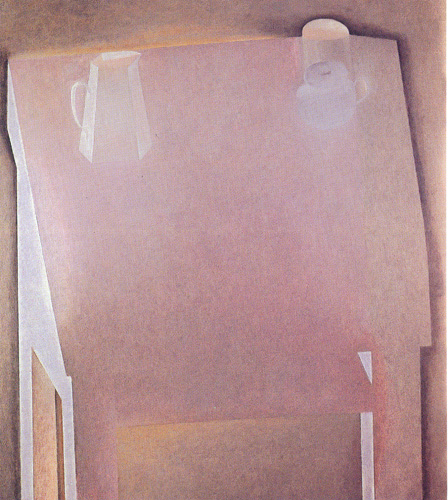
Vigil II.
The self-conscious solitude of Ablow’s objects is a predicament that his paintings never quite lose touch with, even as correspondences of color aspire to unite them. Indeed, solitude the defining reality of the worlds on which their dramas take place—these worlds being, without exception, tables. Whether treated as a stage for a drama of kitchenware or as subjects in their own right, the tables dictate the distortions and distances of space that define each composition.
When perceived as subjects in their own right, the tables in Ablow’s paintings find themselves against nebulous backdrops of shimmering ether, lacking the scenic context that they themselves offer the compositions of kitchenware. Without a single gravitational plane on which to orient a single or shared perspective, Ablow sees these planetary bodies arranged on separate dimensions wholly their own. In “Congregation, the tables’ legs and bowed surfaces interact between contradictory surface planes, the effect being that they appear light years away from each other. Veils of iridescent color resolve their divisions of space, breathing them into a shared, luminous, dramatic presence across their disparate dimensions. The white cloth at right, meanwhile, remains in another realm altogether, despite claiming to lay on the surface of the right-hand table. He floats in the well of his own dense shadow as if the folds of his flesh were of the fabric of space and time.
The white cloth’s shadow, in addition to situating the white cloth on a separate plane from the tables, accumulates dramatic significance when seen in relation to the larger black shadow seemingly cast by the table at left. Likewise, the cells of pure color that characterize so many of Ablow’s depictions of pitchers, cups and bowls, are decisive in dramatizing their separations of space. At once that they divide one being from the next, they articulate evocative correspondences across their emotional landscape upon the table’s surface.
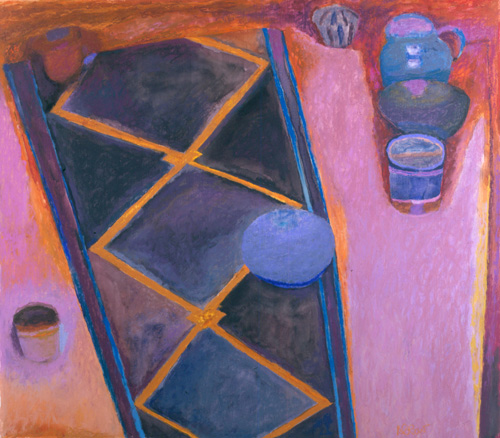
Still Life with Kilim
In “Still Life with Kilim,” for instance, the dark blue pattern of a Turkish table rug at once adds structure to the visual landscape and also, by virtue of the vertical rigidity of its blocks of dark blue, seemingly insurmountable divisions to the characters who inhabit it. Between the lands of bright orange and pepto-pink, a blue plate waits to cross, between two edges, perhaps forever. A glint of orange to his right prefigures his first move. Meanwhile, his ceramic comrades watch the impasse in solidarity on a red earth that wraps the orange-pink island, marking a territory that the blue plate seems destined never to meet.
This all plays out on the surface of a table which is, as throughout Ablow’s still-lifes, tilted vertically to the surface of the canvas, as if to put his players on dramatic display. Even when the surface of the table is not his focus, Ablow’s vision lifts the plane of emphasis forward in view. This gives his paintings something in common with those of Cezanne and other modernist painters who pursued a human experience of vision. Without relying on outside signifiers for meaning, color values come forward and recede not according to a scientific perspective so much as their perceived significance in relation to human thoughts and feelings. Ablow observed that like music, such works of art “evoke and convey all sorts and levels of experience, but only by implication.”
Unlike more abstract 20th century artists, such as Kandinsky, who aimed to express the structure of music in visual terms, Ablow’s work never loses touch of the “look of things,” as he put it. Though at some moments his objects nearly dissolve into flattened planes of color, the tables or kitchenware consistently remain recognizable as individual objects. For this reason, the formal problems Ablow faces are more similar to those of the early Italian Renaissance portraitists he named as influences. Giovanni Bellini, Piero della Francesca, Fra Angelico, explore, like Ablow does for his inanimate characters, the peculiarities that define their figures. Like Ablow, they also orient their figures’ drama toward the surface of the canvas, using architectural planes in space as a foil for their human dramas.
In “Virgin of the Annunciation” for instance, Fra Angelo stages Mary and the angel on a shallow spread of orange carpet between two cathedral pillars, which, upon closer inspection, are miniature in comparison to these women. Here Old Italian master sets the stage for this holy visitation, sizing it in proportion to human significance rather than according to laws of gravity or of perspective. With a similar motive does Ablow lift his tables up to the surface of their canvases, up toward his human eyes and toward the human heart.

Installation shot, Qualities of Stillness: Paintings by Joseph Ablow. Photo courtesy of Kate Butler.
Qualities of Stillness: Paintings by Joseph Ablow was on view January 22 -- March 20, 2016. at BU's Stone Gallery.
- Still Life with Kilim, courtesy of BU Art Galleries.

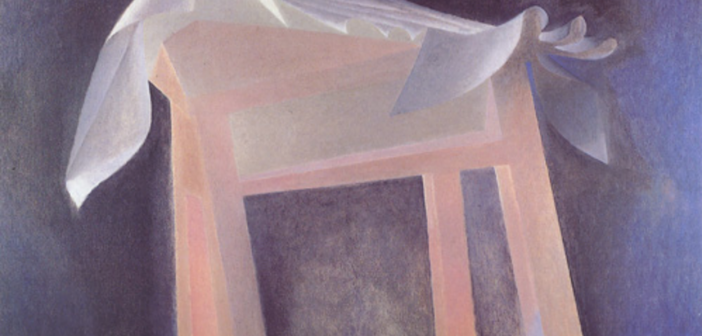

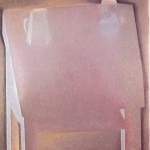
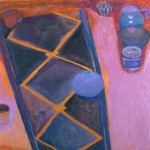
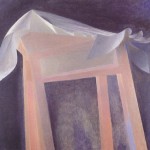


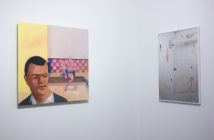
1 Comment
Pingback: Review: Joseph Ablow: Quality of Stillness | //*